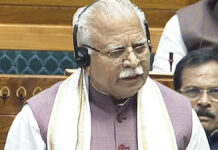India could benefit from the likely shift in global supply chains from China to other economies in the aftermath of the COVID-19 pandemic, according to a survey . The Ficci-Dhruva Advisors Survey conducted this month covered more than 150 companies in India. “Another major outcome of COVID-19 is the likely shift in global supply chains away from China to other economies. Nearly 70 per cent of the survey participants have said India could benefit from this move and they expect a fair share of manufacturing to shift from China to India in the near future,” said Ficci on the findings of the survey. Moreover, the prospect of introduction of a vaccine against COVID-19 early next year has improved the confidence level of businesses, with almost 74 per cent of the participants foreseeing a significant positive impact on their business once the vaccine is made available, the survey revealed. However, to capitalise on the opportunities that could come India’s way, there is need to strengthen its manufacturing ecosystem. Under the Aatmanirbhar Bharat package, the government has introduced several measures to address the immediate pain points of the economy as well as steps to improve India”s manufacturing competitiveness. These measures have been well received by the industry, with 45 per cent of the surveyed companies rating the latest set of announcements made under Aatmanirbhar Bharat package 3.0 as ”good to excellent”. “The results of the survey are encouraging and highlight the ongoing industrial and economic recovery. This momentum needs to be built upon and now all eyes are on the upcoming Budget,” Ficci President Uday Shankar said. He observed that the context of this Budget is completely different due to an unprecedented social and economic challenge, exuding confidence that the government will take bold steps to respond to these challenges. According to the survey, COVID-19-induced travel restrictions have limited the ability of companies to undertake business operations efficiently, as 74 per cent of the respondents have validated this. To overcome this challenge and maintain business operations, companies have leveraged digital tools for communication. Given the benefits of use of technology, 64 per cent of the surveyed firms said moving forward, they will use a mix of travel and virtual meetings even after the situation becomes normal. The results of the December 2020 survey also indicate that there has been a further improvement in the performance of companies compared to the situation in August. With improvement seen in the economy, nearly 40 per cent of the surveyed firms are operating at a capacity utilisation level of over 70 per cent, vis-a-vis 30 per cent of the companies in August 2020. Other indicators of improving business performance in the recent survey are related to order books and exports. Nearly 50 per cent of the companies have reported seeing an increase in their order books and about 40 per cent said their exports have increased. In the August 2020 survey, the corresponding figures were 44 per cent and 30 per cent, respectively. However, even as there are signs of improvement in performance of businesses, the impact of COVID-19 still lingers, as the survey results show that businesses continue to face challenges on account of weak demand (59 per cent), managing costs (54 per cent) and financial liquidity (48 per cent), Ficci stated. Given this, the survey participants expect both government and RBI to continue with their support measures even next year. There is a strong demand that the upcoming Budget must prioritise growth-oriented measures, including a cut in direct tax rates. “The survey results portray a continued improvement in the business environment in India, with weak demand and managing costs still remaining India Inc’s key challenges. The vaccine news has infused optimism among businesses,” Dinesh Kanabar, CEO, Dhruva Advisors LLP said. He further said given the impact of the pandemic on the economy, the Union Budget 2021-22 is one of the most anticipated Budgets. “It would be interesting to observe the growth-oriented measures, which are introduced and if tax cut proposals are tabled,” Kanabar added.

Dogra Herald is the media of J & K, breaking language and geographical barriers, connecting J & K to the rest of India.
0191 245 4946
info@dograherald.com
Latest articles
COVID-19: Declare travel history or face legal action, say authorities in Kashmir
iamjkstarr - 0
People who entered Kashmir after March 1 have to declare their travel history within two days or face legal action, authorities said on Tuesday...
DLSA Srinagar organizes plantation drives
iamjkstarr - 0
In continue to Plantation Drive, started by Chief Justice of High Court of J&K, Justice Gita Mittal, DLSA Srinagar today organized Plantation Drives and...
Extensive traffic checking conducted in Doda
DOGRA HERALD BUREAUDODA, Nov 17The officials from various departments in Doda laid special nakas and conducted traffic checking at different locations along...

























